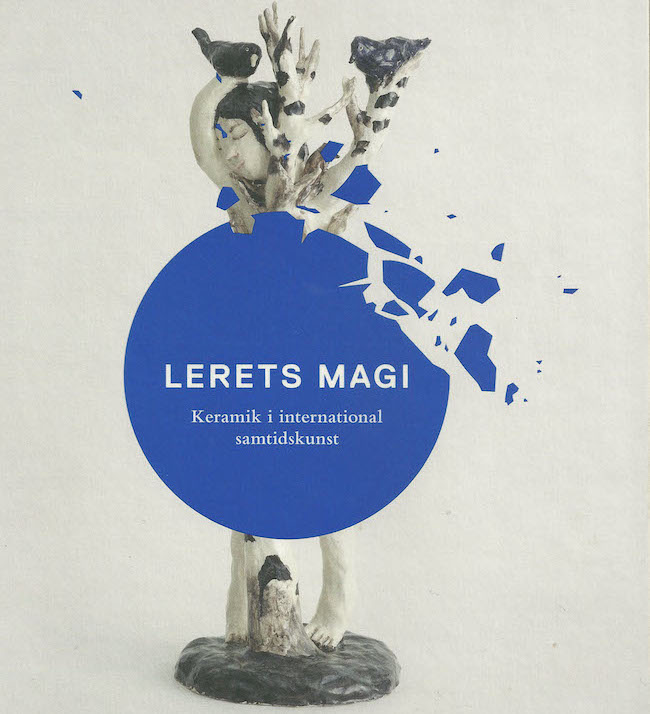Lerets Magi: Keramik i international samtidskunst
Forward by Mads Damsbo, director G1 Holtesgaard
& Edited by Mads Damsbo and Louise Birch Sorensen
Gl Holtegaard, , 2011
Hardcover exhibition catalog, 179 pages. 115 illustrations. 9 x 11.5 inches
The Art Exhibition catalog has come a long way since its long running staple-bound format. Substantial exhibitions now frequently provide “book” quality offerings in conjunctions with their shows and the catalog for glHoltegarrd’s exhibition of the same name, Lerets Magi: Keramik i international samtidskunst ( The Magic of Clay – Ceramics in Contemporary Art), for their 2011 exhibition, is a good example of this recent evolution. It’s 179 pages of well thought-out writings, beautifully reproduced photographs of the artists’ works and an insightful interview into the process of curating the show to complete it.
Like any curated thing, however, the pages of Lerets Magi have an aim; all 13 of the artists represented in the exhibition share a number of fascinations with regard to clay: the long and cultural history of clay, its malleability and, after firing, its rigidity, and, in the works of David Cushway, Clare Twomey and others, the seeming immortality of ceramics as they rest in the earth testing time and the elements and keeping its peculiar record of us.

Kaspar Bonnen, Shapes of Myself 2010-11, different objects, photographs, etc. Photograph by Anders Sune Berg.
These themes are primordial, they look to the beginning and to the outcomes of time itself. These artists ask many questions of the past. Kaspar Bonnen, the Danish artist, uses clay to recreate things forever lost to his past. With the limitless expressiveness of clay he pulls from his memory the lost image — raising it like a golem from a little mud and some muttered words — of some childhood thing. These ceramic works then take their place alongside notes, pictures and other ephemera from Bonnen’s life, creating a complex narrative of the everyday.
Bonnen’s obsession with the past is unique, however, in the face of the other artists whose preoccupations lie with a larger history. Ai Weiwei’s works respond to the rich cultural history of Chinese ceramics both as art form and as a commonplace industrial necessity. The catalog contains some fine photos of his installation Bamboo and Porcelain where long stocks of bamboo connect pots at the floor and the ceiling of the gallery; as if time marched on and the vessel —its usefulness, but also its elegance, kept pace with the ages being, like the bamboo, always present, always forming.

Ai Weiwei, Bamboo and Porcelain, 2009, porcelain (two blue vases), bamboo stick, 44 x 28 cm
Clare Twomey’s Present Traces takes a polarized approach to Ai Weiwei’s. Installed in a rotunda (small grassy circle) in front of the glHoltegaard, Twoley arranged and smashed 1000 ceramic plates. The plates are a mix of contemporary and historical Danish household pieces. They’re now invited to mix with the old in the earth where they shall keep our cultural record safe, and hauntingly unchanged.
Other predominate themes in the catalog are metamorphosis, both towards theme in the intellectual sense and in the sense of the process of working with clay. Edmund de Waal’s essay High Unseriousness – artists and clay eplores this concept through a discussion of artists like Gaugain, Miro and Picasso to much more contemporary names like Ken Price. Of Price de Waal says, “It is this feeling of a continuing metamorphosis into the unknown… the characterizes the work of Ken Price.” But, it seems this ‘”unknown” quality of clay is what compels the majority of the artists discussed in the essay; or rather, clay’s defiance at being defined, its often innate inability to stay still.

Clare Twomey, Present Traces (detail), 2011, mixed ceramics. Photograph by Anders Sune Berg.
The other artists range greatly in their approach: Davdi Cushway, Thea Djordjadze, Alexandra Engelfriet, John Korner, Jonathan Meese, Hylton Nel, Grayson Perry, Linda Sormin, Klara Kristalova and Alexander Tovborg all have admirable sections with good showings of their work. Lerets Magi is a great volume for those looking for inspiration, for something to think about, for new names, ideas and concepts. It’s also a nice piece of eye candy.
Christopher Johnson is CFile’s Book Reviewer.
Any thoughts about this post? Share yours in the comment box bellow.

Hylton Nel, Set of 9 Posing Lady Plates, 2009, glazed ceramics, 26 cm diameter.

Add your valued opinion to this post.